As I may have mentioned in the previous entry, I spent the latter half of this year begrudingly sequestered in Beijing, inhaling pollutants, dodging lawless bicyclists, and consuming foods of questionable safety. But what I neglected to admit was that even though I complained endlessly while there, two weeks back on this side of civility, I started to miss China. Like, a lot. Washbasins, barrels, man-made-lake sized volumes of miss. So much so that it looks like I’ll be moving back there in a few months and staying for a good portion of 2012.
In the meantime, I've been indulging in the newfound appreciation for my cultural heritage by hunting down films that feature China at its most stylish and among these include the undeniable 1960 Paramount classic The World of Suzie Wong.
The World of Suzie Wong is actually based on a 1957 book of the same name written by Richard Mason and has since been adapted into not only this hit film, but also a play and a ballet, and spawned various unofficial sequels. The storyline is as old as “the oldest profession” from which it draws its inspiration. Set in the 1950s, William Holden stars as the young Englishmen Robert Lomax who, after leaving the National Service, decides to temporarily squat in Hong Kong and try his hand at becoming an artist. He unwittingly takes up residence at a hotel/brothel and eventually falls in love with one of its most popular prostitutes, Suzie Wong (Nancy Kwan).
Now even though I've always loved this movie, it bears mentioning that my love for it comes with certain reservations, as the theme of "whore with the heart of gold" meeting a man of respectable status who thenceforth redeems her has never sat well with me, the same way that similar pictures such as Pretty Woman (1990), Moulin Rouge (2001), Mighty Aphrodite (1995), or even Pygmalion/My Fair Lady tend to leave a slight distaste in my mouth. But in lieu of hitting you with a longwinded feminist diatribe, I think it's better to just adhere to the purposes of this blog and focus on the costumes and art direction instead. And what glorious beauty lies in store for us on those fronts!
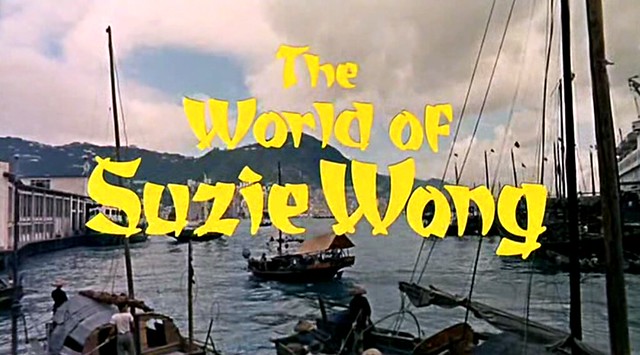
These are actual shots of the Hong Kong's Victoria Harbor! Many people may not realize that the city we know as Hong Kong actually consists of several islands, with "Hong Kong" officially referring to just one of them. Kowloon is the other well-known one, lying just north of Hong Kong Island and connected via ferries that shuttle people back and forth periodically throughout the day.
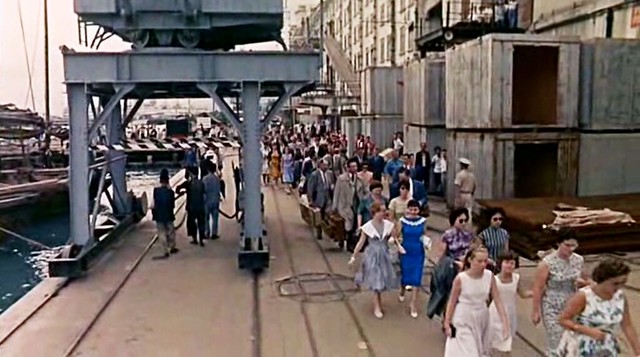
The first time Robert meets Suzie Wong is on one of these ferries.
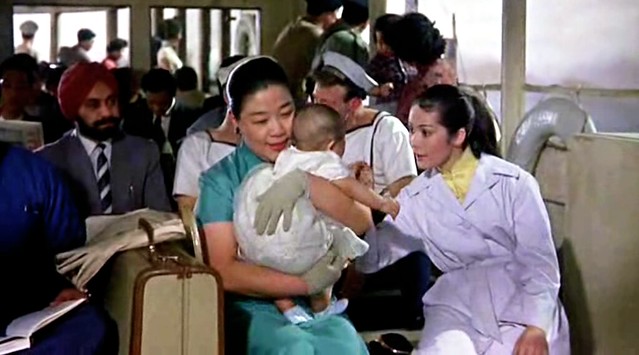
Struck by her beauty, he starts to sketch her. (brain-fart: it just occurred to me that the semi-slang term "sketchy" could very well have been derived from guys who creep women out on public transport when they pull out a pen and notebook and start to sketch them. Yeah? Etymologically incorrect but it still kind of makes sense, no?)
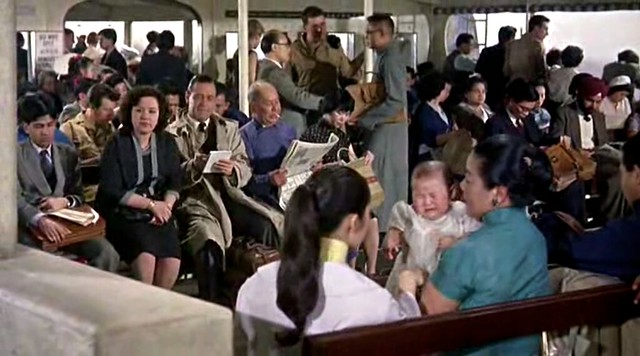
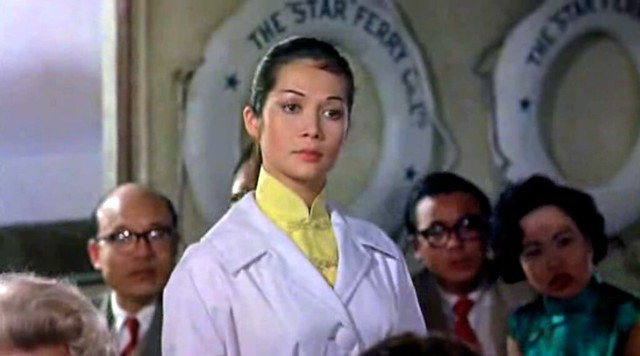
Robert ends up renting a room at the Nam Kok Hotel, which was inspired by the real-life Luk Kwok Hotel located in Wanchai district. The Luk Kwok Hotel of the 1950s was torn down in the 1980s and reopened in 1990 as part of Hong Kong's first "office-hotel complex." The gleaming modern edifice that stands today is a far cry from the ramshackle structure that was once akin to this:
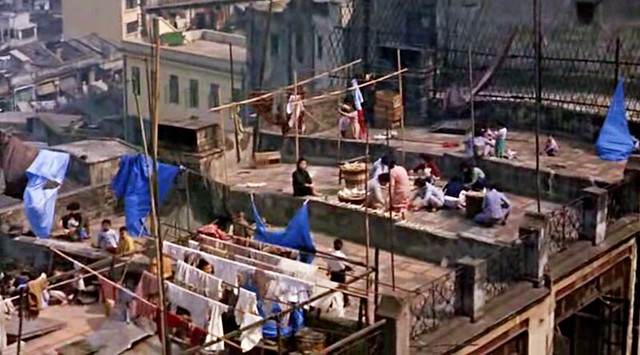
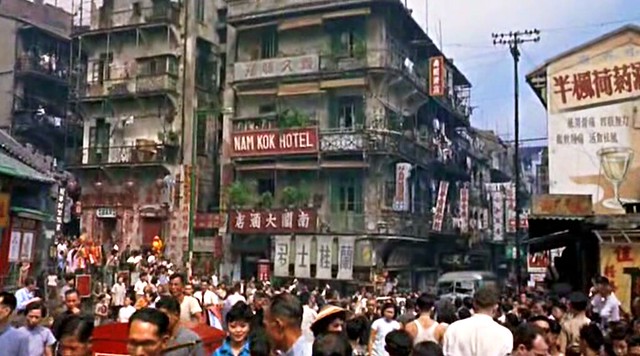
The atmosphere of the hotel's interior, particularly the bar area, is intoxicating! Dimly lit, enveloped in cigarette smoke, and festooned with all the expected ethnic ostentation of such establishments, it is precisely the kind of venue dispirited veteans and restless sailors like to retreat to for a night of unbridled revelry where a little money gets you a helluva lot.

Robert quarantines himself in a corner booth, more keen on studying and sketching the environment than partaking in the merriment.
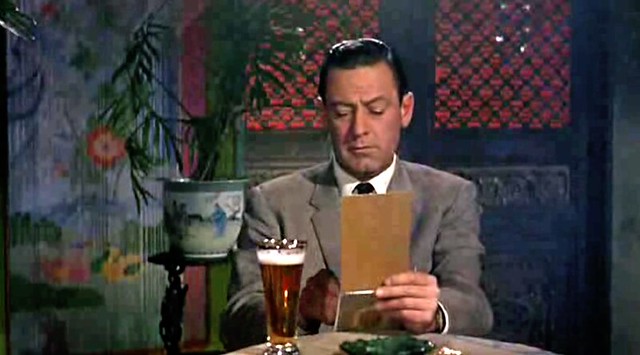

And then Suzie Wong re-enters Robert's visual field, and subsequently, changes his life.

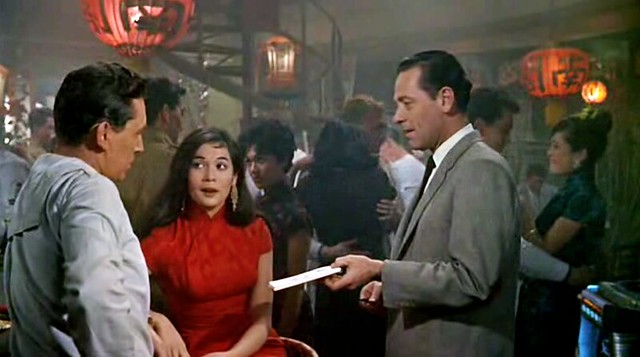
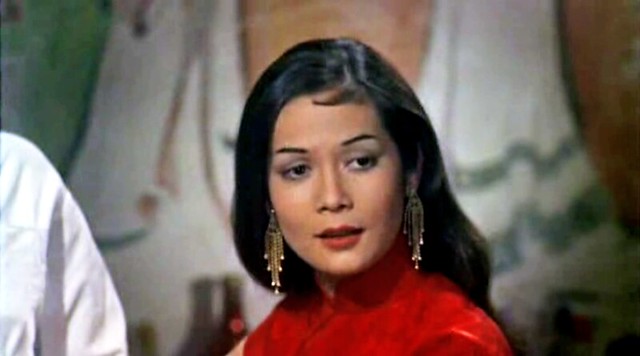
Perhaps the most drool-worthy aspect of this film is Suzie's collection of form-fitting qi-paos (aka cheongsams in Cantonese). This traditional Chinese dress was originally baggy and boxy. The more tailored design emerged in Shanghai in the 1920s as wealthy, society ladies sought a more form-fitting aesthetic to show off their figures (Shanghai was considered "the Paris of the East" during that era and while seeds of revolution were taking root in the north, Shanghai was still intent on partying it up). The high-necked, short-sleeved version with the revealing side slits became popularized as "the standard" shortly thereafter and the dress eventually became available in a variety of fabrics, affording lower classes the ability to adopt the fashion as well. The qipao suffered a period of decline as the Communist Revolution ultimately took hold of the Mainland with its egalitarian ideals and utilitarian fashions but the dress, brought over by Shanghainese emigrants, retained its popularity in Hong Kong.
While the Art Direction was under the management of John Box (Doctor Zhivago, A Passage to India, The Great Gatsby), the costumes were designed by Phyllis Dalton (Henry V, The Princess Bride). It's interesting to note that all of Suzie's qi-paos were of one, solid color, a distinction that sets hers apart from the multi-colored, multi-patterned qi-paos of her peers. Even today, most off-the-rack qi-paos are multi-colored and it's actually more difficult to find one that isn't!
Iconic red:
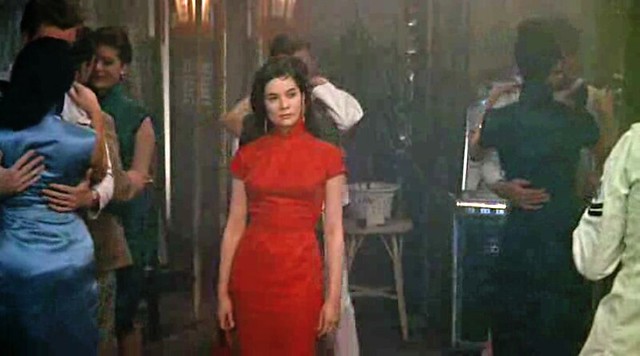
Robert hires Suzie out pose as an art model (instead of as a "companion," much to her dismay).
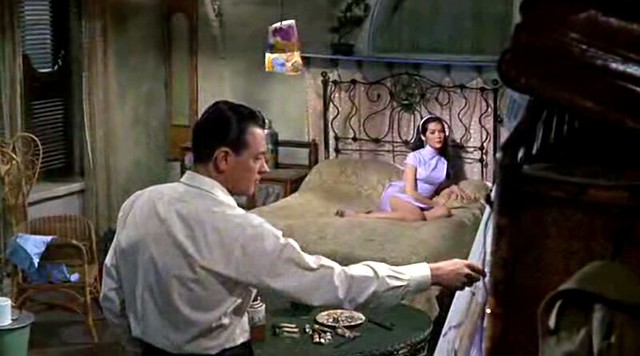
Lavender qi-pao, with matching lavender headband.
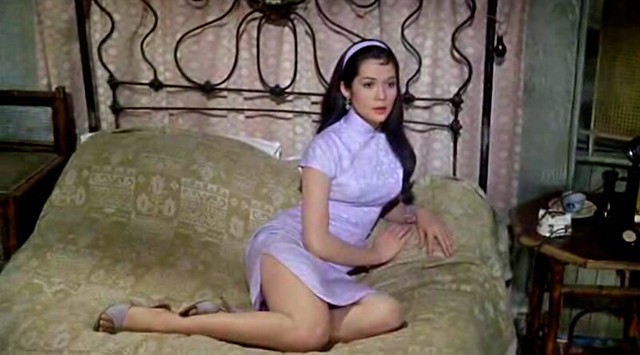
Complemented with beautiful green jade earrings.
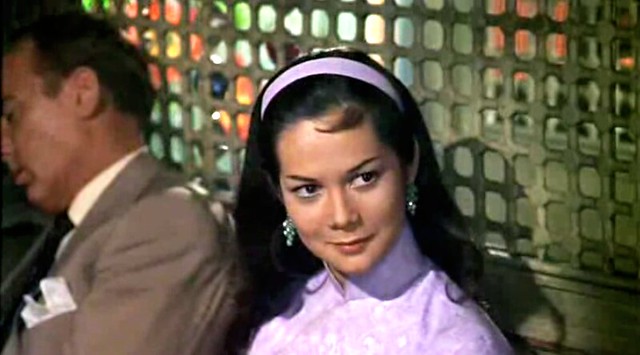
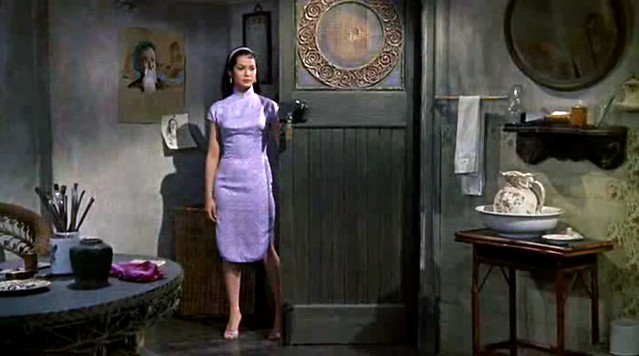
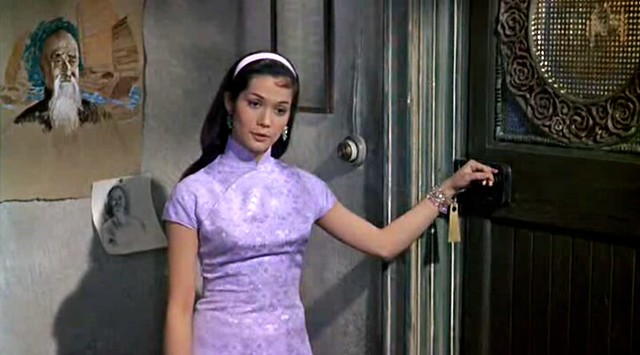
Whoa, work it, woman!
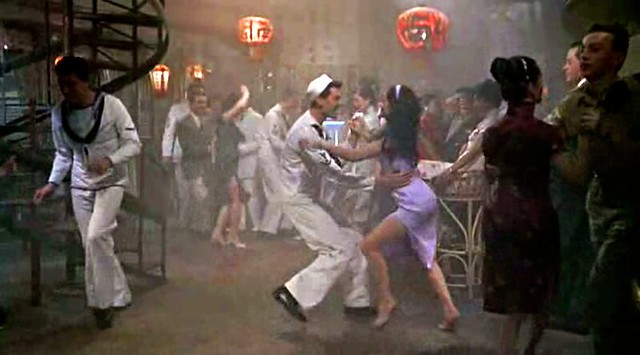
Orange-coral colored qi-pao:
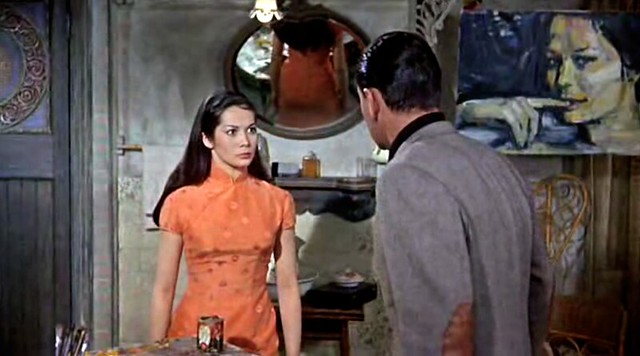
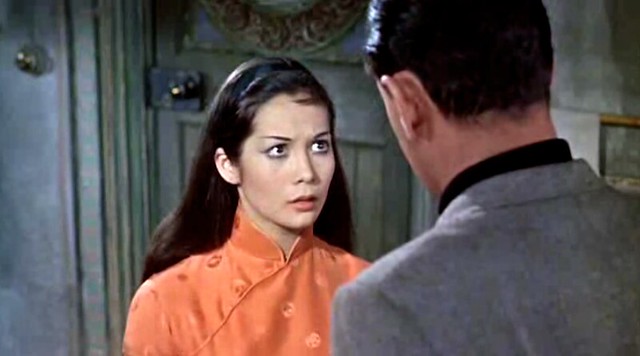
Gold sleeveless qi-pao:
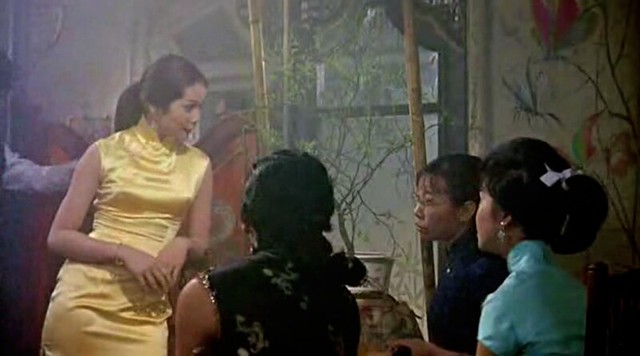
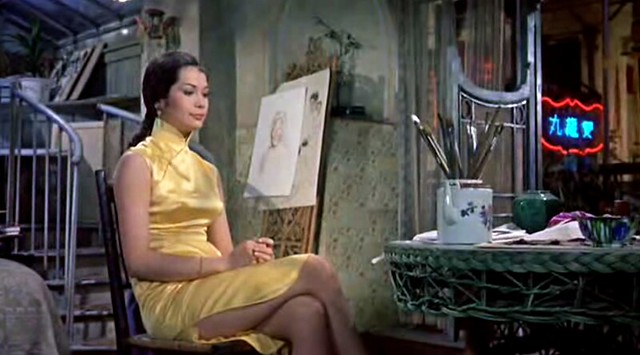

Dark brown qi-pao:
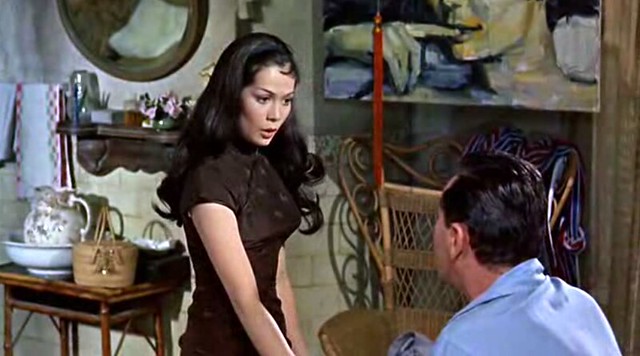
Light tan qi-pao:

White qi-pao:
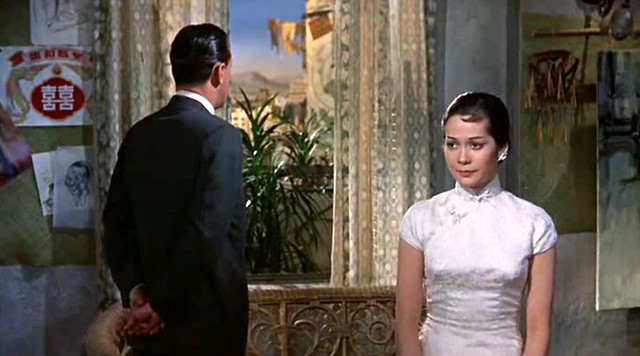
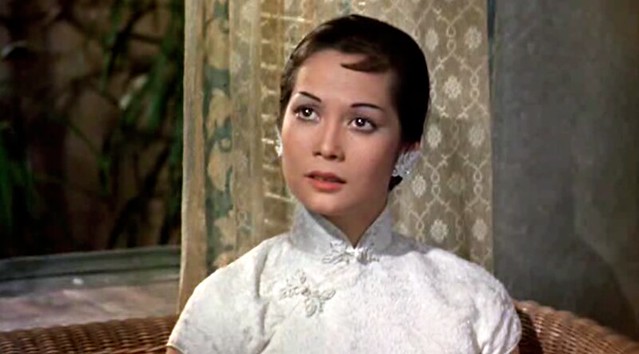
And my personal favorite: dark greenish-black with a slight sheen worn with sheer black gloves and a long double looped gold necklace. Breathtaking.
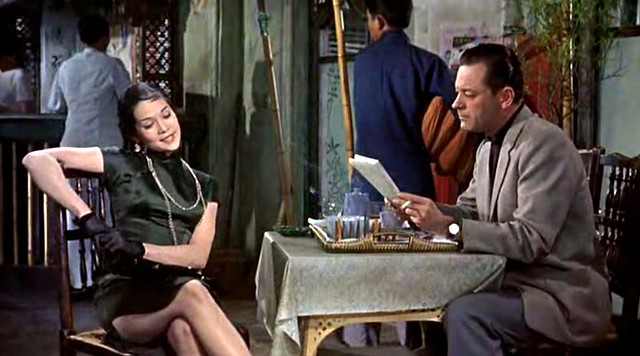
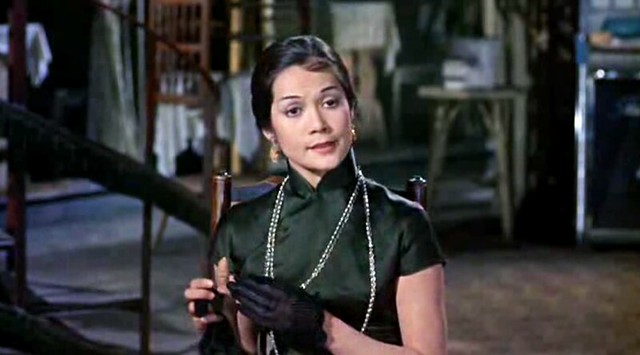
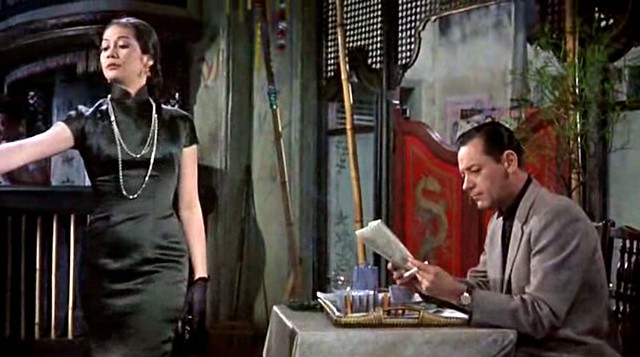
There are a few occasions when Suzie dons on something other than a qi-pao. Here she is unwittingly channeling Audrey Hepburn. Also, that white blouse is so Carolina Herrera.
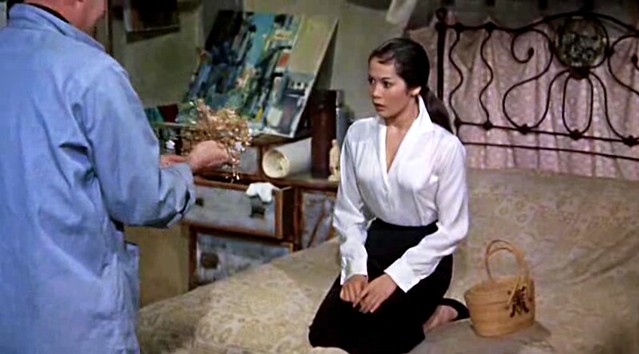
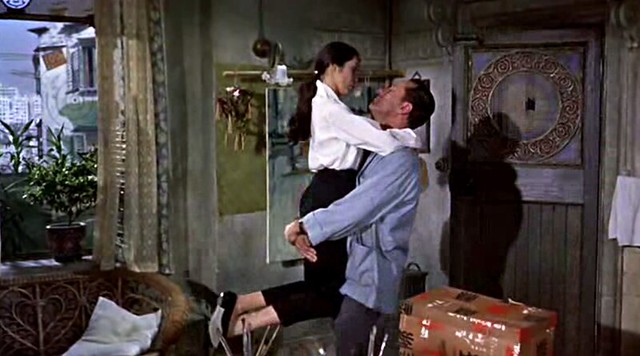
Suzie in a more relaxed shirt, black tapered pants, carrying a straw tote/basket. Robert is getting a haircut from a street-side barber. And he's not too thrilled about it either.
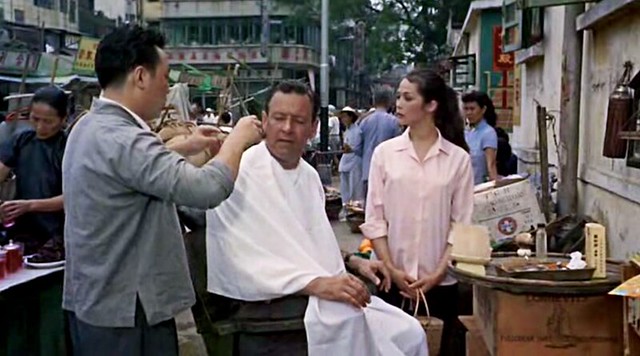
Suzie in "peasant" clothes, with the stereotypical conical Asian straw hat.
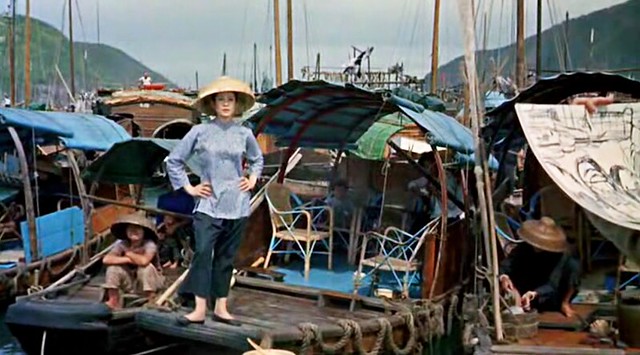
In stark contrast, Suzie in an Empress costume!
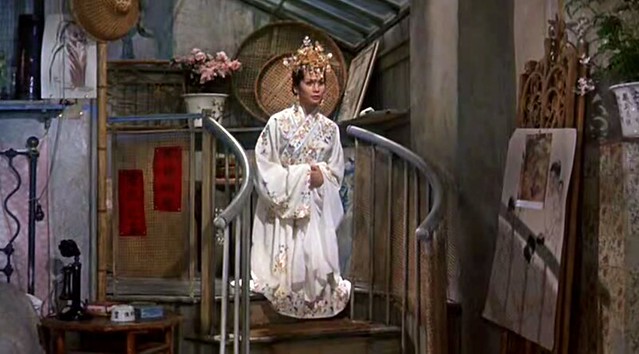
The one time Suzie appears in "Western clothes." I'm not so fond of the blue monstrosity sitting on top of her head but the dress is okay.
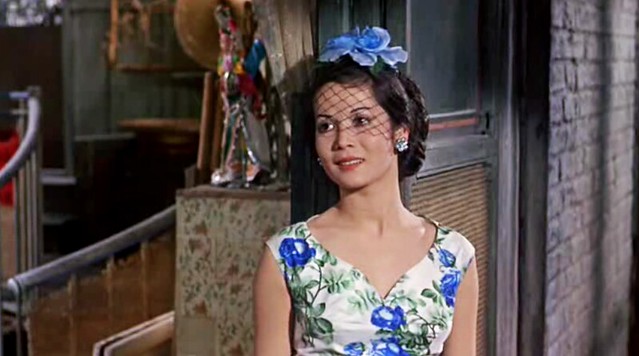
Robert hates it. Demands she revert back to her old style.
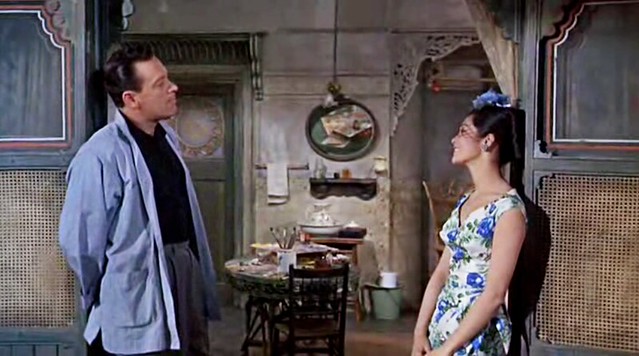
Before moving onto the other characters and their outfits in the film, it may be of interest to note that Nancy Kwan was only half-Chinese. Her father was from Hong Kong but her mother was Caucasian, of English and Scottish descent. I find it hypocritical that while in scene above where Robert reprimands Suzie for belying her ethnic identity with "ridiculous" Western ensnarements, Hollywood itself couldn't handle the idea of casting an ethnically homogenous actress as the female lead (in much the same way as Natalie Wood was passed off as Puerto Rican in West Side Story and David Carradine as the Chinese monk/martial arts master in the television series Kung Fu). While featuring half-Asians on the big screen is definitely a step forward, using them to represent a "full-blooded" Asian character can be debated as disingenuous. Just my 2 cents...
Anyways, moving on... Suzie's friends (most of whom were also "working girls") can be found in more embellished qi-paos, trimmed with sparkly sequins and colorful embroidery. I wonder if Phyllis Dalton dressed Kwan in definitively subdued qi-paos to lend the character an air of respectability and hence, the potential for redemption?
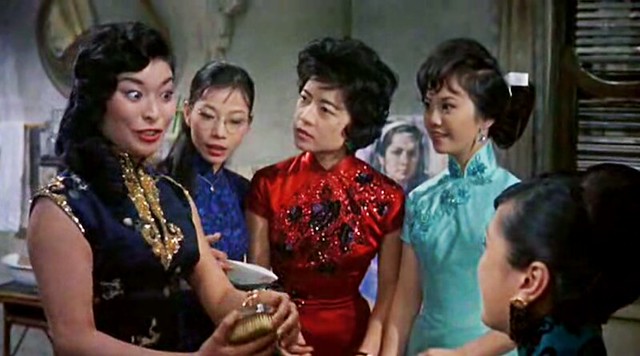
Suzie brings her friends into Robert's hotel room and proudly does a show-and-tell of his Western paraphernalia. Here she tells them about the merits of "a letter of introduction"!
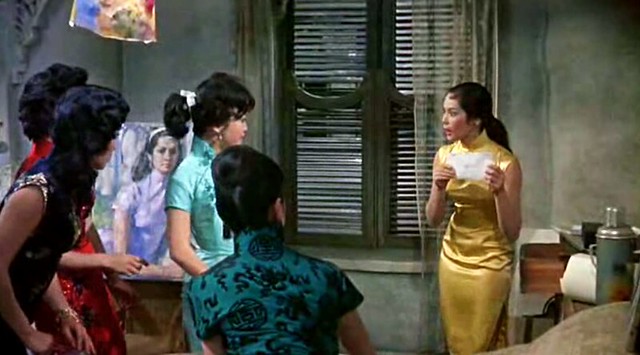
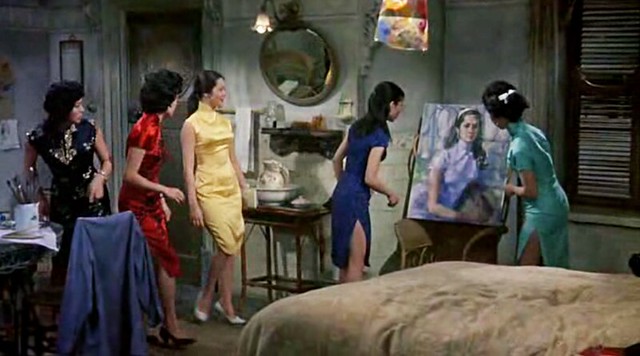
Look! Socks from England! I'm enamored with the teal qi--pao with the black overlay (what a gorgeous color!)
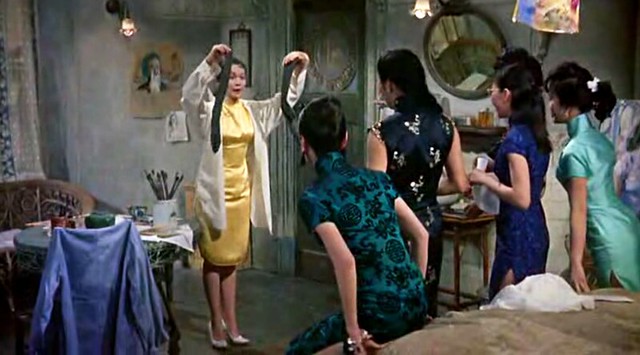

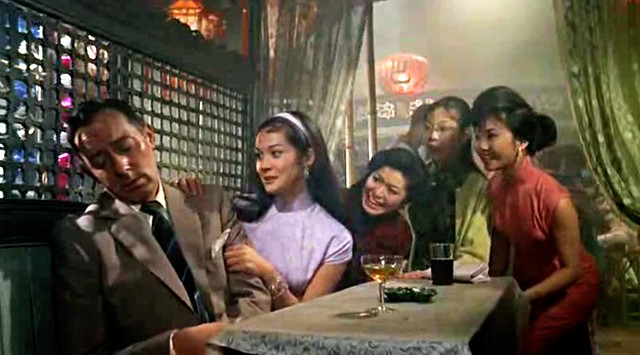
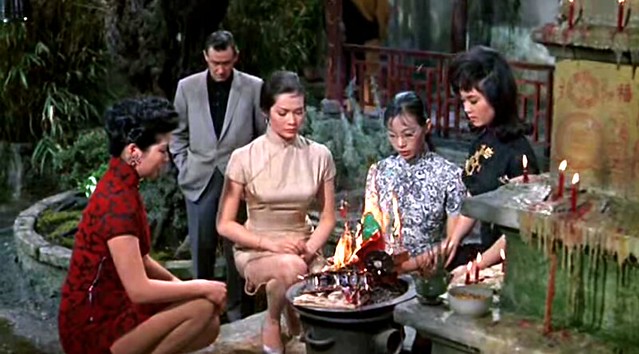
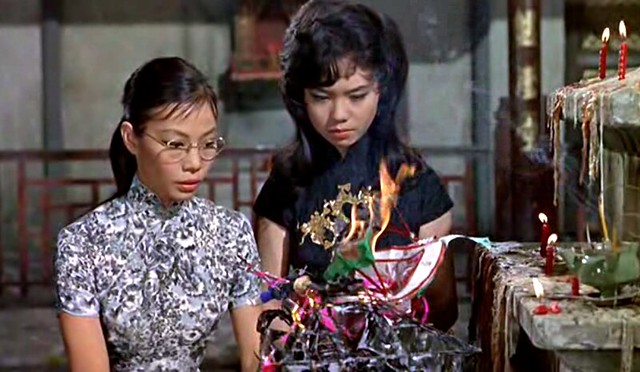
Below is the Japanese-Canadian actress Yvonne Shima in a black and red patterned qi-pao. I also really like her up-do.
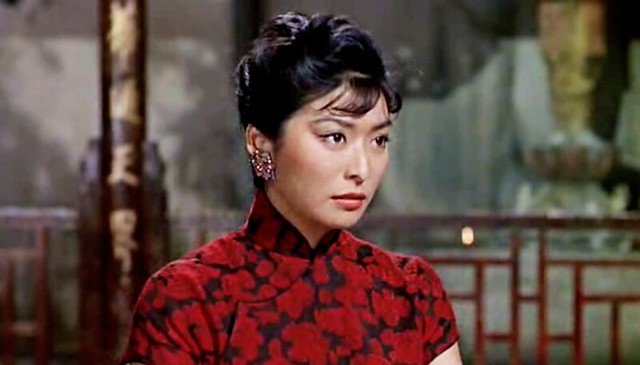
The mildly tempered character of Gwennie (Jacqui Chan), who insists on wearing cardigans to hide her skinny arms provides, provides a foil to the fiery passions of the other girls. She is also almost never without her knitting.
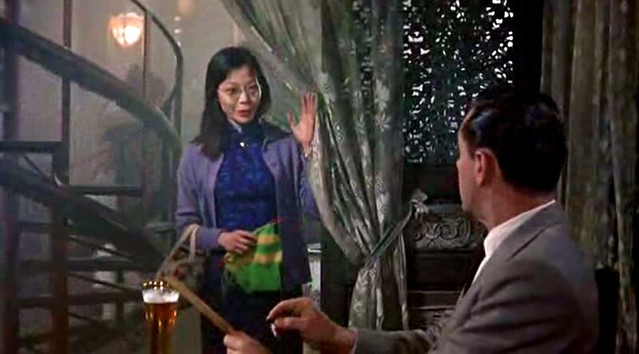
I should have been paying more attention when rewatching this film because I'm actually a little confused about Gwennie. Was she actually a prostitute? Because why else would she hang out at the bar every night? In this scene below, she was waiting outside the hotel and when Robert happened to pass by, she promptly asked him to escort her inside (because apparently it was a social faux-pas for a woman to enter a bar unaccompanied). Actually, now that I think about it, I'm pretty sure she was also "one of the girls" but her meek, pious, almost granny-like disposition tends to let you think otherwise.
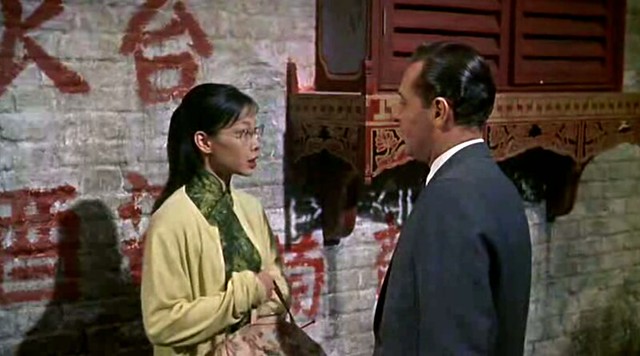
Gwennie and Robert actually end up as good friends, as she becomes the person to whom he would often confide, particularly when it comes to his feelings for Suzie.
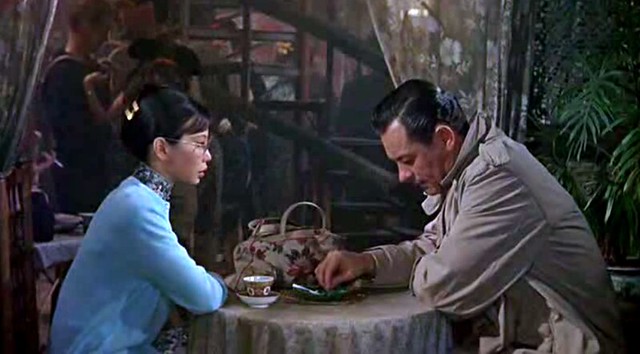
On the flip side of the coin is Kay (Sylvia Syms), the daughter of a wealthy banker whom Robert went to see about setting up a bank account when he first arrived in Hong Kong. Kay falls in love with Robert and tries to help him sell his art.
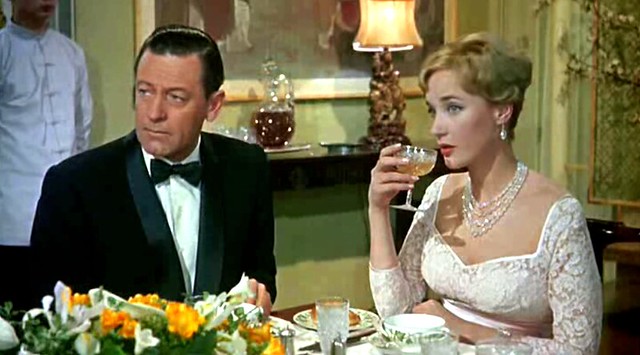
I was put off by the plethora of white lace at first but then decided that this dress is actually quite exquisite, particularly from the waist down. Note the pink stripes:
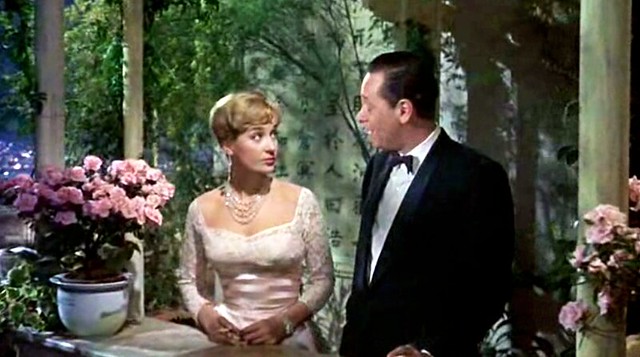
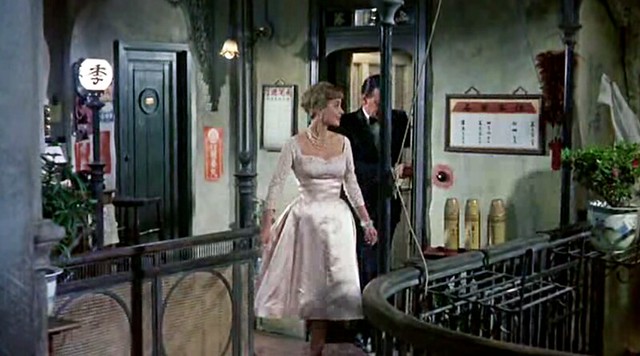
Kay works as her father's secretary and when on the job, can be found dressed in typical secretarial attire. The sheen on this taupe blouse is lovely.
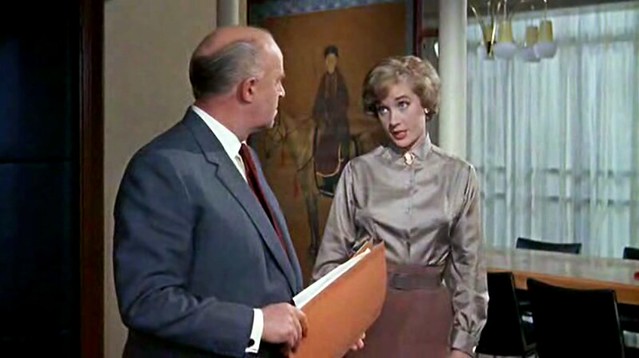
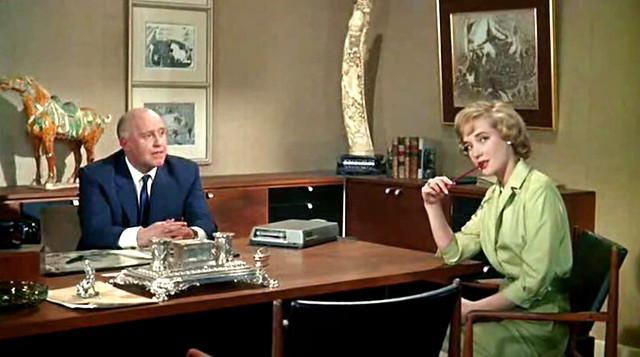
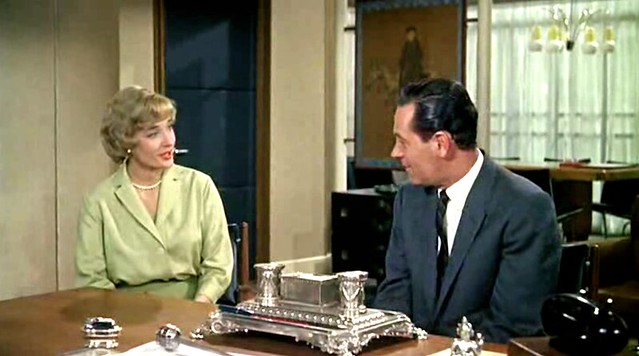
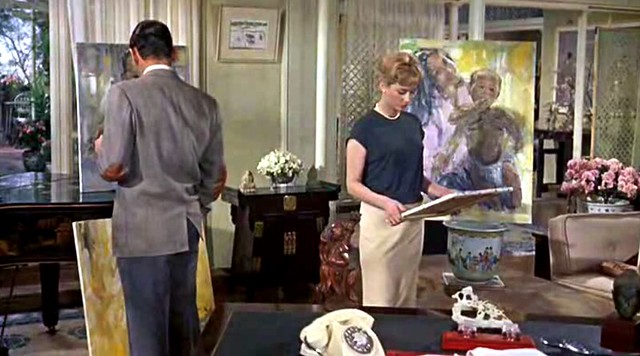
This lavender dress should have been more tailored to her body. The sleeves are slightly puffy and trimmed with little ball-like details (is there a proper term for this kind of adornment?)
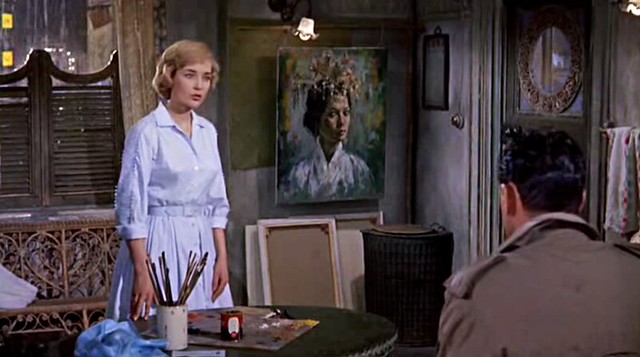
So Robert is presented with two very different women from two very different worlds, both of whom love him deeply. What a lucky guy.
And finally some design elements to note. The interior of the hotel:
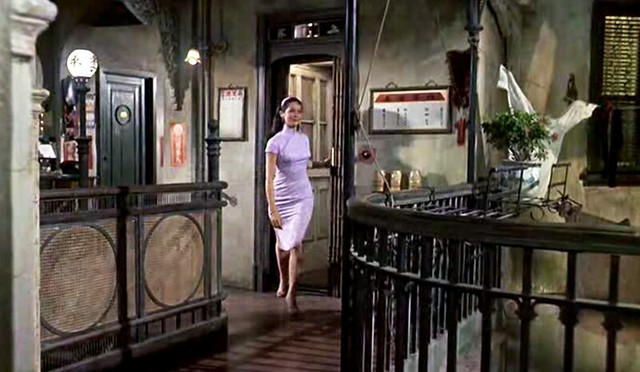
Really beautiful rattan/bamboo details. I don't know what the pieces that sit on top of the banisters and reach up to the ceiling would be classified as. Dividers? Moldings? Trim?
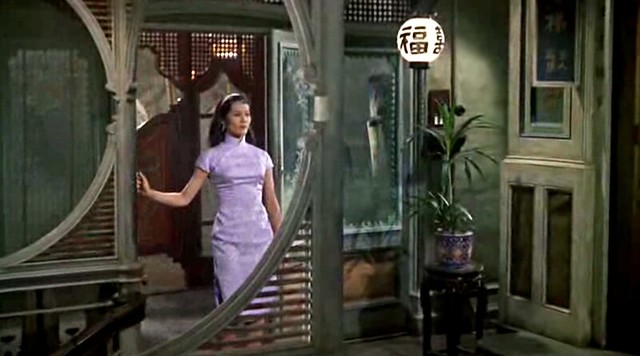
Door decoration.
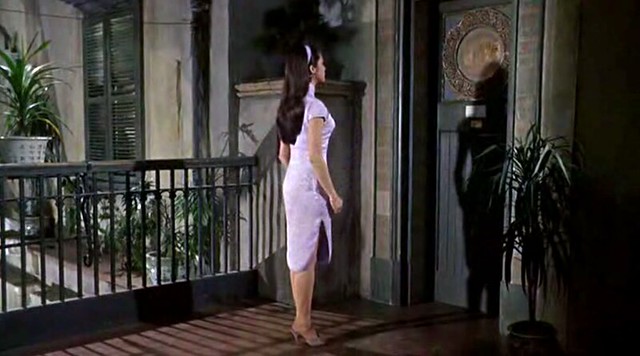
The interior of Robert's rented hotel room:

In contrast, this is the interior of Kay and her father's house, which aside from a few Asian inspired pieces, mostly adheres to the mid-century aesthetic of that period.
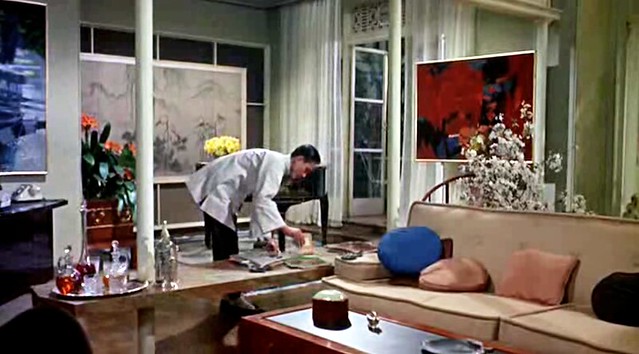
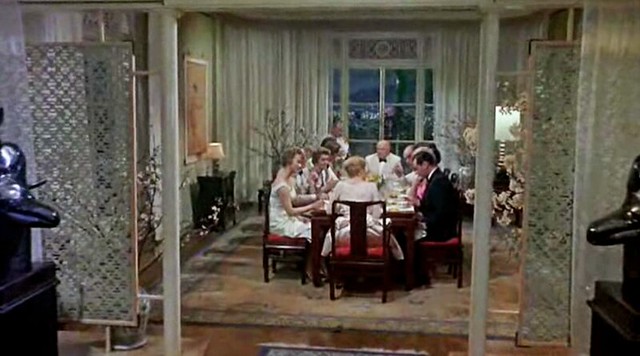
In the meantime, I've been indulging in the newfound appreciation for my cultural heritage by hunting down films that feature China at its most stylish and among these include the undeniable 1960 Paramount classic The World of Suzie Wong.
The World of Suzie Wong is actually based on a 1957 book of the same name written by Richard Mason and has since been adapted into not only this hit film, but also a play and a ballet, and spawned various unofficial sequels. The storyline is as old as “the oldest profession” from which it draws its inspiration. Set in the 1950s, William Holden stars as the young Englishmen Robert Lomax who, after leaving the National Service, decides to temporarily squat in Hong Kong and try his hand at becoming an artist. He unwittingly takes up residence at a hotel/brothel and eventually falls in love with one of its most popular prostitutes, Suzie Wong (Nancy Kwan).
Now even though I've always loved this movie, it bears mentioning that my love for it comes with certain reservations, as the theme of "whore with the heart of gold" meeting a man of respectable status who thenceforth redeems her has never sat well with me, the same way that similar pictures such as Pretty Woman (1990), Moulin Rouge (2001), Mighty Aphrodite (1995), or even Pygmalion/My Fair Lady tend to leave a slight distaste in my mouth. But in lieu of hitting you with a longwinded feminist diatribe, I think it's better to just adhere to the purposes of this blog and focus on the costumes and art direction instead. And what glorious beauty lies in store for us on those fronts!

These are actual shots of the Hong Kong's Victoria Harbor! Many people may not realize that the city we know as Hong Kong actually consists of several islands, with "Hong Kong" officially referring to just one of them. Kowloon is the other well-known one, lying just north of Hong Kong Island and connected via ferries that shuttle people back and forth periodically throughout the day.

The first time Robert meets Suzie Wong is on one of these ferries.

Struck by her beauty, he starts to sketch her. (brain-fart: it just occurred to me that the semi-slang term "sketchy" could very well have been derived from guys who creep women out on public transport when they pull out a pen and notebook and start to sketch them. Yeah? Etymologically incorrect but it still kind of makes sense, no?)

pale lavender trench paired with bright yellow qi-pao.

Robert ends up renting a room at the Nam Kok Hotel, which was inspired by the real-life Luk Kwok Hotel located in Wanchai district. The Luk Kwok Hotel of the 1950s was torn down in the 1980s and reopened in 1990 as part of Hong Kong's first "office-hotel complex." The gleaming modern edifice that stands today is a far cry from the ramshackle structure that was once akin to this:


The atmosphere of the hotel's interior, particularly the bar area, is intoxicating! Dimly lit, enveloped in cigarette smoke, and festooned with all the expected ethnic ostentation of such establishments, it is precisely the kind of venue dispirited veteans and restless sailors like to retreat to for a night of unbridled revelry where a little money gets you a helluva lot.

Robert quarantines himself in a corner booth, more keen on studying and sketching the environment than partaking in the merriment.


And then Suzie Wong re-enters Robert's visual field, and subsequently, changes his life.



Perhaps the most drool-worthy aspect of this film is Suzie's collection of form-fitting qi-paos (aka cheongsams in Cantonese). This traditional Chinese dress was originally baggy and boxy. The more tailored design emerged in Shanghai in the 1920s as wealthy, society ladies sought a more form-fitting aesthetic to show off their figures (Shanghai was considered "the Paris of the East" during that era and while seeds of revolution were taking root in the north, Shanghai was still intent on partying it up). The high-necked, short-sleeved version with the revealing side slits became popularized as "the standard" shortly thereafter and the dress eventually became available in a variety of fabrics, affording lower classes the ability to adopt the fashion as well. The qipao suffered a period of decline as the Communist Revolution ultimately took hold of the Mainland with its egalitarian ideals and utilitarian fashions but the dress, brought over by Shanghainese emigrants, retained its popularity in Hong Kong.
While the Art Direction was under the management of John Box (Doctor Zhivago, A Passage to India, The Great Gatsby), the costumes were designed by Phyllis Dalton (Henry V, The Princess Bride). It's interesting to note that all of Suzie's qi-paos were of one, solid color, a distinction that sets hers apart from the multi-colored, multi-patterned qi-paos of her peers. Even today, most off-the-rack qi-paos are multi-colored and it's actually more difficult to find one that isn't!
Iconic red:

Robert hires Suzie out pose as an art model (instead of as a "companion," much to her dismay).

Lavender qi-pao, with matching lavender headband.

Complemented with beautiful green jade earrings.



Whoa, work it, woman!

Orange-coral colored qi-pao:


Gold sleeveless qi-pao:



Dark brown qi-pao:

Light tan qi-pao:

White qi-pao:


And my personal favorite: dark greenish-black with a slight sheen worn with sheer black gloves and a long double looped gold necklace. Breathtaking.



There are a few occasions when Suzie dons on something other than a qi-pao. Here she is unwittingly channeling Audrey Hepburn. Also, that white blouse is so Carolina Herrera.


Suzie in a more relaxed shirt, black tapered pants, carrying a straw tote/basket. Robert is getting a haircut from a street-side barber. And he's not too thrilled about it either.

Suzie in "peasant" clothes, with the stereotypical conical Asian straw hat.

In stark contrast, Suzie in an Empress costume!

The one time Suzie appears in "Western clothes." I'm not so fond of the blue monstrosity sitting on top of her head but the dress is okay.

Robert hates it. Demands she revert back to her old style.

Before moving onto the other characters and their outfits in the film, it may be of interest to note that Nancy Kwan was only half-Chinese. Her father was from Hong Kong but her mother was Caucasian, of English and Scottish descent. I find it hypocritical that while in scene above where Robert reprimands Suzie for belying her ethnic identity with "ridiculous" Western ensnarements, Hollywood itself couldn't handle the idea of casting an ethnically homogenous actress as the female lead (in much the same way as Natalie Wood was passed off as Puerto Rican in West Side Story and David Carradine as the Chinese monk/martial arts master in the television series Kung Fu). While featuring half-Asians on the big screen is definitely a step forward, using them to represent a "full-blooded" Asian character can be debated as disingenuous. Just my 2 cents...
Anyways, moving on... Suzie's friends (most of whom were also "working girls") can be found in more embellished qi-paos, trimmed with sparkly sequins and colorful embroidery. I wonder if Phyllis Dalton dressed Kwan in definitively subdued qi-paos to lend the character an air of respectability and hence, the potential for redemption?

Suzie brings her friends into Robert's hotel room and proudly does a show-and-tell of his Western paraphernalia. Here she tells them about the merits of "a letter of introduction"!


Look! Socks from England! I'm enamored with the teal qi--pao with the black overlay (what a gorgeous color!)





Below is the Japanese-Canadian actress Yvonne Shima in a black and red patterned qi-pao. I also really like her up-do.

The mildly tempered character of Gwennie (Jacqui Chan), who insists on wearing cardigans to hide her skinny arms provides, provides a foil to the fiery passions of the other girls. She is also almost never without her knitting.

I should have been paying more attention when rewatching this film because I'm actually a little confused about Gwennie. Was she actually a prostitute? Because why else would she hang out at the bar every night? In this scene below, she was waiting outside the hotel and when Robert happened to pass by, she promptly asked him to escort her inside (because apparently it was a social faux-pas for a woman to enter a bar unaccompanied). Actually, now that I think about it, I'm pretty sure she was also "one of the girls" but her meek, pious, almost granny-like disposition tends to let you think otherwise.

Gwennie and Robert actually end up as good friends, as she becomes the person to whom he would often confide, particularly when it comes to his feelings for Suzie.

On the flip side of the coin is Kay (Sylvia Syms), the daughter of a wealthy banker whom Robert went to see about setting up a bank account when he first arrived in Hong Kong. Kay falls in love with Robert and tries to help him sell his art.

I was put off by the plethora of white lace at first but then decided that this dress is actually quite exquisite, particularly from the waist down. Note the pink stripes:


Kay works as her father's secretary and when on the job, can be found dressed in typical secretarial attire. The sheen on this taupe blouse is lovely.




This lavender dress should have been more tailored to her body. The sleeves are slightly puffy and trimmed with little ball-like details (is there a proper term for this kind of adornment?)

So Robert is presented with two very different women from two very different worlds, both of whom love him deeply. What a lucky guy.
And finally some design elements to note. The interior of the hotel:

Really beautiful rattan/bamboo details. I don't know what the pieces that sit on top of the banisters and reach up to the ceiling would be classified as. Dividers? Moldings? Trim?

Door decoration.

The interior of Robert's rented hotel room:

In contrast, this is the interior of Kay and her father's house, which aside from a few Asian inspired pieces, mostly adheres to the mid-century aesthetic of that period.





12 comments:
fantastic post! the bit of history on the fit of traditional dresses was great. i had no idea. after seeing in the mood for love, i've had this theory that chinese dresses are designed to show off women's figures in the extreme. not intentionally cruel, but when you watch how the lady sort of negotiates her movements and the way it forces her to sort of undulate as she walks...
this was a great movie and the sets look fantastic.
Loved this post!
Only thing to note: I was so annoyed by her silly fringe curl - so strange!
I really enjoyed reading this, especially your thoughts on racial and gender role stereotypes.
As is often films of this ear are filled with sexists dialogues and settings, as Mad Men constantly remind us of.
Though the costumography, the acting itself is vastly superior to (almost) anything that's being made today.
You're back! Great pick and great comments on the icky gender politics that inherent in these kinds of films.
This is not necessarily true. Bungalows tend to offer large, open spaces and generous sized garden.
Property Association Management
A late comment: Thanks for the work of setting up all the stills, and your commentary on fashions, esp your speculation that Suzie might have been dressed in subdued qi-paos to set up her "redemption", etc. Saw the movie when I was about 12 (at a drive-in with parents!), read the novel as a teen (along with Greene, Maugham, etc), and revisited both while travelling in China on business. The novel is significantly better (and more persuasive) than the movie, which for all its "orientalist" cultural and sexual stereotyping, did still capture something of both the "romance" of 50's HK for westerners, and the muse/model and artist dynamic (including, in the novel, the non-trivial challenges of cross-cultural relationships). Thanks for the pix!
@alphanaut99 Thanks for your comment! I haven't had the chance to read the novel yet but thanks for the recommendation! I find that, in general, the original book version is almost always better than its film adaptation. But I also agree with you that in spite of all its flaws, the movie was still really enjoyable!
Love this film as a HK resident - we have to remember it's 50+ years old and the moral zeitgeist has moved on a bit, fortunately. Of course if you live here, then you appreciate that many of the themes still remain as true today, albeit the ethnicity of the 'Wanchai girls' has changed to SE Asian as the Chinese have become wealthier. Plenty of Lomax characters around however...
That"s my memory at all.
I have a prop off the movie, it is a suzie wong night club and bar cigarette case. i was wondering if you or some one you can put me in touch with might be able to answer a few questions and authenticate it
Thanks and that i have a tremendous give: How Much Home Renovation Cost split level home additions
rfywyf49wb
golden goose outlet
supreme outlet
golden goose outlet
golden goose outlet
golden goose outlet
golden goose outlet
golden goose outlet
golden goose outlet
golden goose outlet
golden goose outlet
Post a Comment